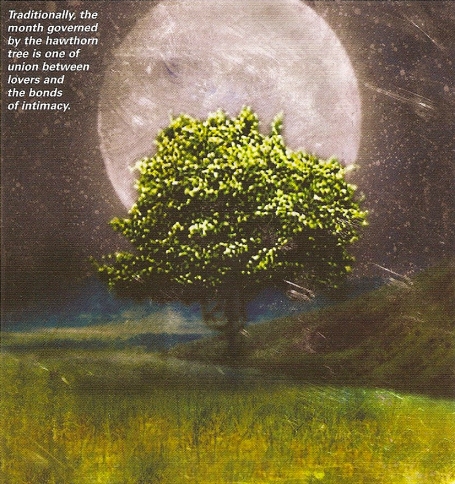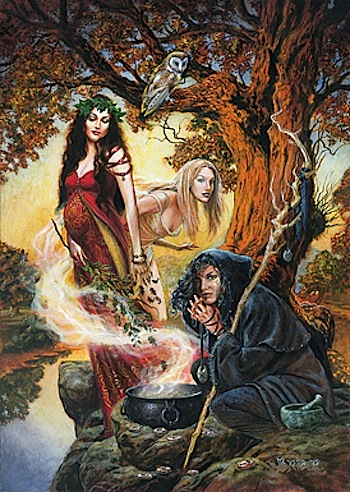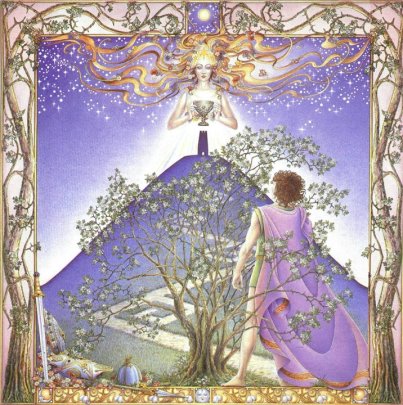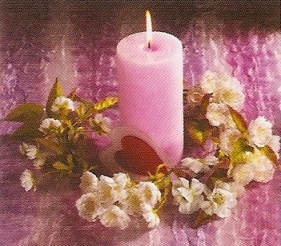
“Autumn Deity” by ~cutieloli
“Maid Marian’s themes are fertility, youthfulness, abundance, energy, beauty and instinct. Her symbols are late-blossoming flowers and forest plants. A predominant figure in the Robin Hood tales, Maid Marian is most certainly a remnant of the ancient youthful Goddess, who blossoms with late summer’s abundance, inspires fertility, re-awakens our instincts, and exudes energy just when our resources seem all but gone.
The Horn Dance dates back to Norman times as a remnant of an ancient fertility and hunting festival. Today it remains as a re-enactment of Robin Hood stories, complete with hobby horse and deer horn dancing for Maid Marian’s fertility, rock candy for life’s sweetness, and a little brandy to keep things warm!
Should you want physical fertility, you can dance with a broom instead. Eat a bit of candy and drink brandy (brandy-flavored candy is also an option) to encourage sweet love and passion to flow in your life!
To draw Maid Marian’s presence to any effort today, bring late-blossoming flowers into your home, office, or any place you visit. If you get organic ones, nibble on a rose. Digest the Goddess’s beauty within so it will manifest without.
Finally, wear shades of forest green, the traditional colour for Robin Hood’s clan, so you can figuratively accept a spot beside Maid Marian as an ally who fights against injustice and stands firm for good causes.”
(Patricia Telesco, “365 Goddess: a daily guide to the magic and inspiration of the goddess”.)

“Maid Marion” by William Clarke Wontner
According to Wikipedia, “The earliest medieval Robin Hood stories gave him no female companion. Maid Marian was originally a character in May Games festivities (held during May and early June, most commonly around Whitsun) and is sometimes associated with the Queen or Lady of May of May Day. Indeed, Marian remained associated with such celebrations long after the fashion of Robin Hood had faded again. She became associated with Robin Hood in this context, as Robin Hood became a central figure in May Day, associated as he was with the forest and archery. Both Robin and Marian were certainly associated with May Day festivities in England (as was Friar Tuck); these were originally two distinct types of performance — Alexander Barclay, writing in c.1500, refers to ‘some merry fytte of Maid Marian or else of Robin Hood’ — but the characters were brought together.
The Marian of the May Games is likely derived from the French tradition of a shepherdess named Marion and her shepherd lover Robin (not Robin Hood). The best known example of this tradition is Adam de la Halle‘s Le Jeu de Robin et Marion, circa 1283.
Marian did not immediately gain the unquestioned role as Robin’s love; in ‘Robin Hood’s Birth, Breeding, Valor, and Marriage‘, his sweetheart is ‘Clorinda the Queen of the Shepherdesses’. Clorinda survives in some later stories as an alias of Marian.
In narrative terms, Maid Marian was first attached to Robin Hood in the late sixteenth century as Robin was gentrified and given a virginal maid to pine after. Her biography and character have been highly variable over the centuries. Marian’s role was not entirely virginal in the early days; in 1592, Thomas Nashe described the Marian of the later May Games as being played by a male actor named Martin, and there are hints in the play of Robin Hood and the Friar that the female character in these plays had become a lewd parody. Robin was originally called Ryder.

Mary Elizabeth Mastrantonio as Maid Marian in Robin Hood: Prince of Thieves (1991).
In the famous Errol Flynn film, she is a ward of the court, an orphaned noblewoman under the protection of King Richard. In the Kevin Costner epic Robin Hood: Prince of Thieves, she is a maternal cousin to the sovereign, while in the BBC TV Show adaption of 2006, she is the daughter of the former Sheriff and was betrothed to Robin prior to his leaving for the Holy Land. Elsa Watson‘s and Theresa Tomlinson‘s novels, which are told from Marian’s point of view, portray Marian as a highborn Norman girl escaping entrapment in an arranged marriage. With the aid of her nurse, she runs away to Sherwood Forest, where she becomes acquainted with Robin Hood and his men.
In an Elizabethan play, Anthony Munday made her a pseudonym of Matilda Fitzwalter, the historical daughter of Robert Fitzwalter, who had to flee England because of an attempt to assassinate King John. This was legendarily attributed to King John’s attempts to seduce Matilda. The ballad of Robin Hood and Maid Marian which dates at least to the 17th century presents a more active Marion who disguises herself as a page and (unrecognised) holds her own against Robin himself in a sword fight.

Olivia de Havilland as Maid Marian in The Adventures of Robin Hood (1938).
In the Victorian era she reverted to her previous role as the dainty maid. This highborn woman appears in many movies, under various characters: in 1938’s The Adventures of Robin Hood, she is a courageous and loyal woman (played by Olivia de Havilland). Although always ladylike, her initial antagonism to Robin springs not from aristocratic disdain but out of an aversion to robbery; however, in The Story of Robin Hood and His Merrie Men (1952), she, despite being a lady-in-waiting to Eleanor of Aquitaine during the Crusades, is in reality a mischievous tomboy capable of fleeing boldly to the countryside disguised as a boy. With the rise of modern feminism in the 20th century, the character has often been depicted as an adventurer again, sometimes as a crack archer herself. In modern times, a common ending for Robin Hood stories became that he married Maid Marian and left the woods for a civilised, aristocratic life.” [1]

Cate Blanchett as Lady Marian in Robin Hood (2010).
Click here to read a well written review of Lady Marian’s character (played by Cate Blanchett) in Sir Ridley Scott’s new Robin Hood.

Nancy Sherer writes: “Robert Graves identifies Maid Marian as the sea Goddess Marian, a virgin dressed in a blue robe, wearing a string of pearls. Occasionally referred to as Merrymaid, but more commonly known as Mermaid, She was worshipped by merriners, (now spelled mariners) who would sacrifice to her. ‘Mer’ meaning sea, is the origin of the epithet Merry England, –Rose in the Sea.

“Queen Guinevere’s Maying” by John Collier
Like the Goddess, Maid Marian is surrounded with Merry men. Little John, Will Scarlet, Friar Tuck, Robin Hood, and others form a band of thirteen. Morris Men, who perform a stylized folk dance are commonly believed to have been imported from the near east, Moors who danced a Moorish dance. However, a more ancient spelling indicates that these may have been Mari’s men. Mari, the Mother Goddess, fruitful, and compassionate, is usually portrayed holding an apple from the Tree of Life. She turns the Wheel of heaven, and is the mother of the Archer of Love.” [2]
Sources:
Sherer, Nancy. Salmonriver.com, “May Day Origins…“.
Wikipedia, “Maid Marian“.
Suggested Links:
Beltane.org, “The May Queen“.
Bradley, Amanda. Altright-Archieve.net, “A Woman for All Seasons: Lady Marian and the Aryan Female“.
Emery, Clayton. Claytonemery.com, “Floating Bread and Quicksilver: A Robin & Marian Mystery“.
Emery, Clayton. Claytonemery.com, “Flyting, Fighting: A Robin & Marian Mystery“.
Jenkins, Chris. Whitedragon.org.uk, “Lady Godda – Goddess Mercia“.
NicEilidh, Hester. Hesternic.tripod.com, “The Legend of Robin Hood: An exploration of the Pagan themes within this enduring myth“.
Sirenschool.blogspot.com, “Bringing in the May“.
Wigington, Patti. About.com: Paganism/Wiccan, “The Legend of the May Queen and the Queen of Winter“.
Wright, Allen W. Boldoutlaw.com, “Robin Hood and Maid Marian, No. 150“.































